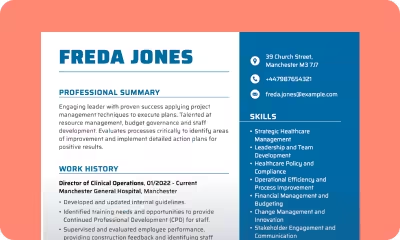How to write a cover letter in 2025
Follow our expert cover letter advice to master the art of writing a cover letter for a job, internship or university application. It may seem challenging at first but we’ll guide you through every step of the process, from crafting your opening to perfecting the final details. We’ll make sure your cover letter format and presentation are in line with UK standards, so that your application looks professional and appealing!

Our customers have been hired by: *Foot Note
In today’s job market, it’s more important than ever to make a good impression. If you want your application to stand out, it’s important to submit a strong set of documents that show off your professional expertise.
While a CV is standard practice, many candidates think a cover letter is optional. That couldn’t be further from the truth. A well-written cover letter is your chance to make a strong first impression and stand out from the competition.
Learn how to write a cover letter that speaks directly to the job requirements and puts you at the top of the candidate shortlist. Read on for expert tips on how to format a cover letter to look professional and leave a lasting impression.
Did you know that a CV alone is not enough when applying for a job? You need a professional, well-structured cover letter that can convince the recruiter that you are a good fit for the company. Follow our cover letter writing advice and check our Cover Letter Builder for best results!
Standard Cover Letter Format
Learn how to write a cover letter that highlights your strengths and sets you apart from other candidates. A standard cover letter format is an important one-page document that accompanies your CV or resume when you apply for a job. It’s your chance to show your enthusiasm and dedication, and make a strong first impression before an employer even looks at your CV.
A well-written cover letter should maintain a professional tone while remaining concise. It should also be tailored to the specific vacancy, demonstrating that you’ve researched the company and understand the role. This personalisation helps your application stand out and shows the employer that you’re genuinely interested in the opportunity, rather than sending out generic applications.
Header: When writing your cover letter, start with your contact information so recruiters can easily get in touch with you for an interview. Start with your name, followed by your address, telephone number and email address. Leave one line empty, then add the date. After another line of space, include the employer’s contact details. This layout makes for a clear and professional presentation.
Salutation: After all the contact details, it’s time to officially kick-off your letter. Use a professional greeting, using the hiring manager’s name (Dear Mr Smith). If you can’t find the name of the recruiter, use a general greeting like Dear Hiring Manager.
Introduction: The first paragraph of your cover letter sets the tone for the rest of the document. Write a concise introduction that effectively presents who you are and immediately grabs the recruiter’s attention. Ideally, your introduction should be 2-4 sentences long.
Main section: The main section of your cover letter is your chance to demonstrate your suitability for the job by highlighting your qualifications and showing how your skills match the job requirements. Consider dividing it into two sections: in the first, discuss your relevant experience and how it has prepared you for this role. In the second, highlight your key achievements and describe the unique value you can bring to the company. This structure allows you to effectively express both your qualifications and your enthusiasm for the role.
Conclusion: The conclusion of your cover letter is your final opportunity to make a positive impression on the employer. Use this section to reaffirm your enthusiasm for the role and your eagerness to discuss the opportunity further. Keep it brief – about the same length as your introduction.
Formal sign-off: The appropriate closing line depends on how you started your letter. If you addressed your letter to a specific person, use “Yours sincerely”. On the other hand, if you used a generic salutation because you didn’t know the recipient’s name, end with “Yours faithfully”.
Addressing your cover letter to the hiring manager by name shows attention to detail. If you can’t find the name, use “Dear Hiring Team” or “Dear Hiring Manager.” Check our cover letter examples for more tips!
Tips for Writing a Cover Letter
Keep it concise: Aim for a one-page cover letter with 3-4 paragraphs highlighting your key achievements and skills relevant to the role. A concise cover letter will help the hiring manager quickly understand why you’re the right person for the job, without overwhelming them with unnecessary details. Focus on making every sentence count by including only the most relevant information.
Prioritise readability: Use clear, even margins (around 1 inch on all sides) and proper spacing between sections to achieve a polished and professional look. Break the text into distinct sections, such as header, salutation, introduction, body and conclusion. Use bullet points where appropriate to draw attention to key skills or achievements.
Use formal language: Maintain a professional and formal tone throughout your application. Avoid using slang or overly casual language. Address the recipient respectfully, using their name if available – such as “Dear Mr Smith” – or, if unsure, use a professional salutation such as “Dear Hiring Manager” or “Dear Hiring Team”.
Choose standard fonts: Stick to widely used fonts for cover letters such as Arial, Calibri or Times New Roman and use a font size of 11 or 12 points for optimum legibility. Avoid decorative or hard-to-read fonts as they can make your letter look unprofessional. Keeping your choice of font consistent with your CV will make your application more cohesive.
Tailor it to the job: Tailor your cover letter for each application to make it more effective. Mention the specific job you’re applying for and the company name to show that your letter isn’t generic. Match your skills, qualifications and experience to the requirements of the job. Research the company to mention a detail or value that resonates with you – this will help convey your genuine interest in the role.
Proofread thoroughly: Check your cover letter carefully for spelling, grammar and punctuation errors, as even minor mistakes can create a negative impression. Make sure all names are spelt correctly, especially the name of the person you are writing to. You may also want to ask a trusted friend or colleague to proofread your letter for clarity and readability. A well proofread document demonstrates your attention to detail and professionalism.
Save as a PDF: Always save your cover letter as a PDF before submitting it to ensure that your formatting is preserved across devices and platforms. A PDF preserves the structure and visual presentation, making it look polished and professional on any screen. Avoid submitting in Word format as it may not display consistently for all recipients.
How to Write a Cover Letter For Your Profession
These days, a cover letter is essential. Using a well-designed cover letter template can make the process much easier.
Many jobseekers struggle to write a cover letter that grabs the recruiter’s attention, highlights their achievements and helps them secure the job. Learn how to write a cover letter that effectively showcases your skills and is tailored to your specific needs.
How to write a cover letter for an internship
- Highlight your education: Start with your educational background, mentioning relevant coursework that relates to the internship.
- Emphasise soft skills: Focus on skills such as teamwork, time management or adaptability that are important for interns.
- Show enthusiasm: Express your eagerness to learn and contribute to the company.
How to write a cover letter for a teaching job
- Discuss relevant experience: Mention any previous teaching experience or related roles, such as tutoring or mentoring.
- Tailor to the school: Research the school’s values and mention why you are a good fit for their educational philosophy.
- Highlight your teaching style: Talk about your teaching style and how it helps students grow, emphasising adaptability in the classroom.
How to write a nursing cover letter
- Mention compassion: Highlight your compassion for patients and commitment to providing quality care.
- Include clinical experience: Reference specific clinical rotations or previous nursing roles that are relevant to the position.
- Show teamwork: Highlight your ability to work as part of a multidisciplinary team with a focus on patient outcomes.
How to write a cover letter for retail
- Emphasise customer service: Showcase your customer service experience and mention how you’ve handled difficult customer situations.
- Highlight sales success: If possible, mention previous sales targets you’ve met or exceeded to demonstrate your impact.
- Show flexibility: Highlight your willingness to work flexible hours, including weekends and holidays.
How to write a cover letter for a promotion
- Reference past contributions: Reference your achievements in your current role, such as any targets you’ve exceeded.
- Demonstrate company knowledge: Show your understanding of the company’s mission and goals, and explain how your promotion aligns with them.
- Suggest new contributions: State what you plan to bring to the new role, including new initiatives or ideas to improve the department.
How to write a cover letter with no experience
- Focus on transferable skills: Emphasise soft skills such as communication, problem solving or leadership that you have gained through school or volunteering.
- Discuss relevant coursework: Mention any coursework or school projects that are relevant to the role.
- Express your willingness to learn: Be clear about your willingness to learn, adapt and grow within the company.
Common Questions About Writing a Cover Letter
What do I write in a cover letter?
A cover letter should briefly introduce yourself and explain why you’re interested in the role and the company. Focus on relevant skills, experience or achievements that make you a strong candidate. Tailor the content of your letter to the specific job and demonstrate how your background matches the employer’s needs. In addition, express your enthusiasm for the role and invite the recruiter to contact you for further discussion.
What are the 3 steps in writing a cover letter?
The three essential steps in writing a cover letter are
- Research and personalisation: Study the job description and the company to tailor your cover letter. Address it to the hiring manager if possible.
- Writing the content: Write an introduction and then highlight your key skills and experience. Use specific examples to illustrate your qualifications.
- Concluding and reviewing: End with a strong closing statement that reiterates your interest and invites a response. Finally, proofread the letter to make sure it’s error-free.
How to structure a good cover letter?
A well-structured cover letter usually follows this format:
- Header: Include your contact details, date and employer information.
- Opening paragraph: Introduce yourself, state the job you’re applying for and briefly mention why you’re interested.
- Middle paragraphs: Focus on your qualifications and relevant experience and how they make you suitable for the role. Use examples to support your claims.
- Closing paragraph: Reaffirm your interest in the position, thank them for considering your application and invite them to contact you.
How to format a cover letter?
A cover letter should have a clean, professional layout. Use a standard font such as Arial or Times New Roman in 10-12 point size with 1-inch margins and left-aligned text. Keep the body of the letter single-spaced and leave a space between paragraphs. Put your name and contact details at the top, followed by the date and your employer’s details. Keep it short, within one page (3-4 paragraphs) and end with a formal closing, such as “Sincerely” or ” Kind regards”, before signing your name.
Key Takeaways About Writing a Cover Letter
- A cover letter is essential – It provides an opportunity to introduce yourself, demonstrate your qualifications and personalise your application, making a strong first impression before the employer even reviews your CV.
- Tailor your cover letter – Always tailor your cover letter to the job you’re applying for, mentioning specific skills, qualifications and experience that match the role and showing you’ve researched the company.
- Follow a professional format – A well-structured cover letter includes your contact details, information about the employer, and is divided into an introduction, body and conclusion, keeping the tone professional and concise.
- Maintain readability and professionalism – Use clear fonts such as Arial or Times New Roman, stick to one page and make sure your letter is well spaced, easy to read and visually appealing.
- Proofread carefully – Check your cover letter for any spelling, grammar or formatting errors, as these can detract from your professionalism and reduce your chances of being shortlisted.
*The names and logos of the companies referred to above are all trademarks of their respective holders. Unless specifically stated otherwise, such references are not intended to imply any affiliation or association with myperfectCV.












